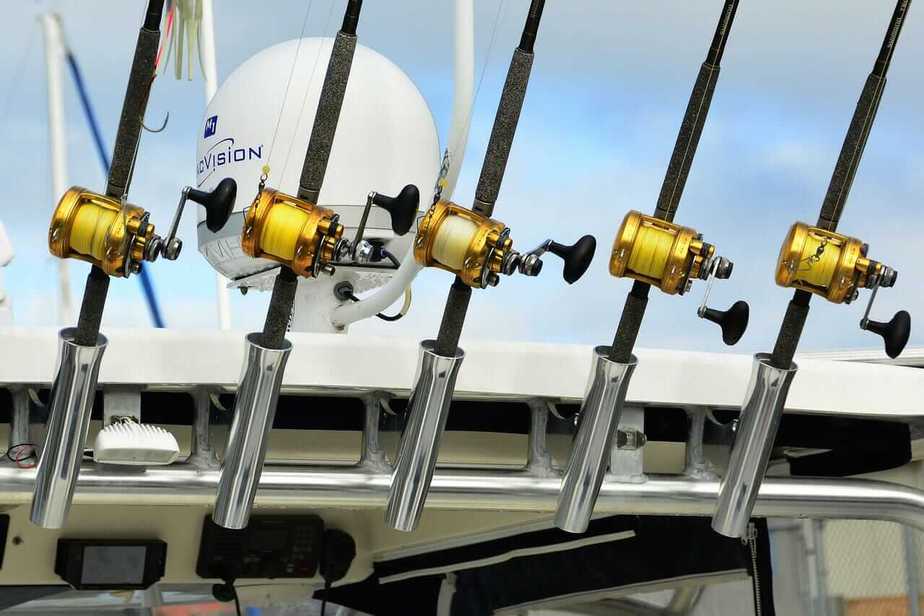Let’s talk about the best fishing line for a baitcaster reel for each type which is currently present on the market. I have decided to share my findings as it took me hours of research before I could find what I was looking for.
Consider checking the below ones:
- Fluorocarbon – Seaguar
- Monofilament – South Bend
- Braided – KastKing
- Fusion – Berkley
Skip Product Description and Keep on Reading by clicking on this link.
Seaguar Blue Fishing Line:
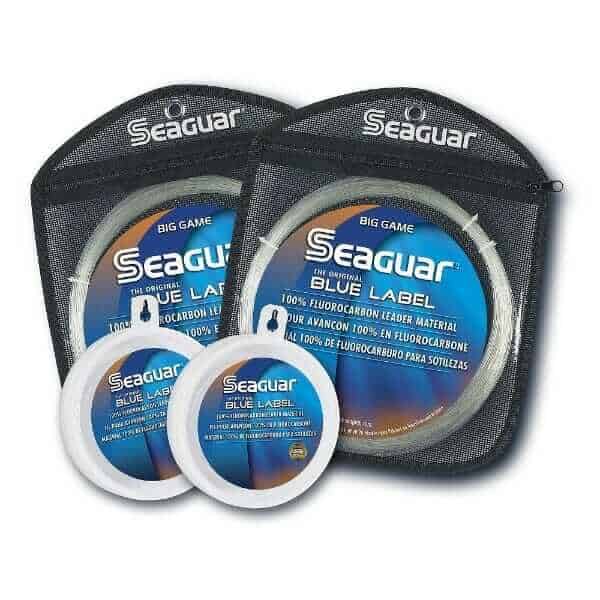
The main advantage of the fluorocarbon line is that it’s nearly invisible underwater. It became possible due to the refraction similarity of water and the line. It sinks quite fast due to its density, which makes it a great choice while fishing with the bottom baits.
You can check the price by clicking on this link.
Such lines are made from polyvinylidene fluoride or polyvinylidene difluoride (PVDF). PVDF is a form of very pure plastic, which makes it one of the best materials for fishing lines.
Fluorocarbon line is very sensitive and even the light bites are easily noticeable. It does not absorb water, which means that the sensitivity and strength of the line does not change while in the water of when dry.
Fishermen choose this line when they aim for the fish which is spooked quite easily and mainly use it in clear waters.
Fluorocarbon line is very sensitive and even the light bites are easily noticeable. It does not absorb water, which means that the sensitivity and strength of the line does not change while in the water of when dry.
Fishermen choose this line when they aim for the fish which is spooked quite easily and mainly use it in clear waters.
Preferably use the below baits with this line type:
- Deep diving crank baits
- Jigging spoons
- Plug lures
- Lipless baits
- Crankbaits
In some cases, fluorocarbon line can cause a “spider web” on your reel due to its low memory. It can happen while casting, as the line will continue to unwound, which might be not so pleasant experience.
One other thing which I would like to mention is that it’s not as elastic as other lines, like monofilament and less stretchy.
In any case, I would say that it’s one of the best line types if you plan to fish for Bass or any other deep water fish. You should definitely test it out and after some time you will love it.
Pros:
- Easy to use
- Extremely tough and very slick
- Very strong for its small diameter
- Holds knots nicely
- Excellent quality
- Smooth
- Great quality
Cons:
- Quite expensive
South Bend Monofilament Fishing Line
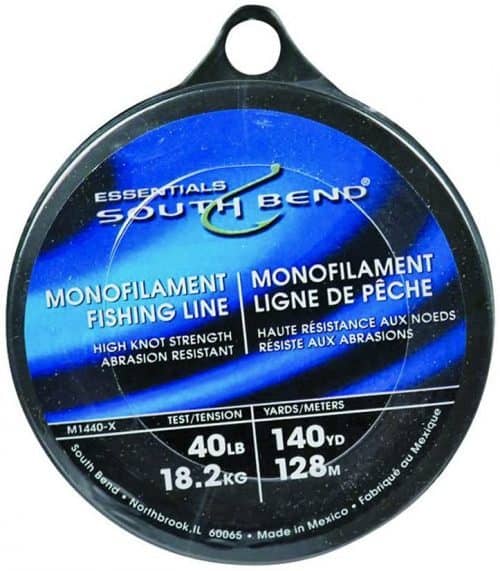
This line type is probably the most popular among the fishermen and comes in a huge variety of colors and sizes. It’s one of the cheapest lines on the market and can be handled with ease.
You can check the price by clicking on this link.
Monofilament line is manufactured from soft monofilament single strand which loses its quality overtime when exposed to ultraviolet light (sun). If you’ll change your line on a yearly basis, you won’t probably even notice that. But, if you don’t, be prepared that the line will sink faster, lose its flexibility and start to break occasionally.
Due to low visibility it’s nearly undetectable underwater. It’s very soft and flexible, which means that even a novice can handle it like a pro. Mono is known for low sink rate, which is a big advantage if you prefer to watch your line while fishing.
If you just starting jour fishing journey, choosing this line type would be the best option.
Best fishing baits for this type of line would be:
- Buzzbaits
- Shakeyheads
- Shallow-water crankbaits
- Poppers
- Prop baits
- Spook lures
Monofilament line absorbs water which can have an impact on sensitivity and increases the chance of losing knots. Be careful while casting as it can break easily when rubbed against the rocks or trees.
It’s not as sensitive as the other lines due to its stretchiness. With mono it’s quite hard to detect light bytes, like with fluorocarbon.
You can use it in all sorts of fishing activities. If you are not sure about the type of line, choose mono as you can’t go wrong here.
Pros:
- Extremely Strong
- Low Memory
- Low Visibility
- Great Line for Beginners
Cons:
- Difficult to Knot
- Not Very Flexible
KastKing SuperPower Braided Fishing Line
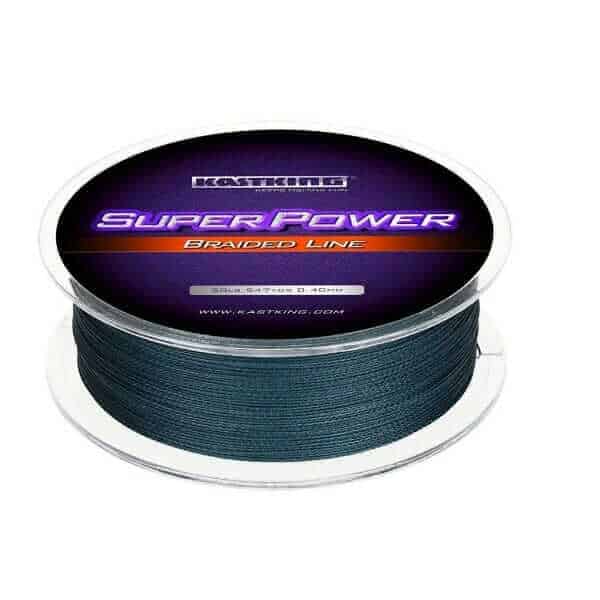
Braided line is well-known for its durability, superior strength while maintaining a small diameter, little or no stretch at all and abrasion resistance. Due to the small diameter, you can set much more line on your reel which is as strong as mono or fluorocarbon.
You can check the price by clicking on this link.
Braided line is produced from synthetic fibers such as Dyneema or Spectra. These fibers offer the maximum strength for minimum weight and diameter.
It’s ideal for heavy cover and other difficult conditions while flipping or casting. More and more fishermen prefer this line type while setting up for bass fishing.
Best lures to use with braided line are:
- Plastic Worms
- Bass Jigs
- Spinnerbaits
- Crankbaits
- Top water Lures
- Soft Plastics
- Rubber Shads
- Natural Bait
It’s expensive and puts more stress on the reel parts which might lead to its breakage. Due to the lack of stretch, the line might break if you encounter strong-hitting fish bite.
In order to cut through this type of line, you will need much sharper instruments, such as knives or other equipment. Not all the knots are suitable for this line. You will need to do a small research in order to determine which ones are the best.
Pros:
- Strong Knot Strength
- Low Memory
- Good Abrasion Resistance
- Ultra-High Sensitivity
- Zero Stretch
- Ultra-Strong for its Small Diameter
- Works Great
Cons:
- Might Leave Colored Residue for The First 15 Casts
- Fast color fade
Berkley Fireline Fused Crystal Superline
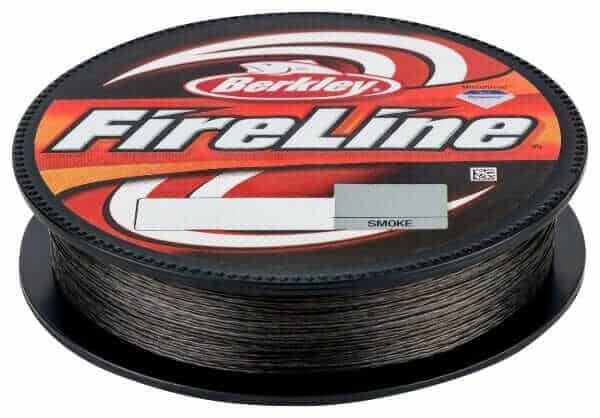
The main advantages of these line types are lack of stretch, great strength for its small diameter, easy bite detection and long casting distance. You can expect the increase in casting distance up to 20% when switching to fusion. It works best on baitcasting and spinning reels, but that mainly depends on the type of fishing.
You can check the price by clicking on this link.
Fusion lines are made from Spectra or Micro-Dyneema oriented-strand gel which is braided by the machine. Spun fibers made from these materials are then extruded under heat and pressure. When compressed and bonded together, they make a stiffer line which is amazingly strong.
You might notice a slight stiffness of the line when you first set it on the reel. The main reason for that is the bonding coating which is applied to the line. It will wear off after some time and make the line more limp and of a dull color. You will definitely notice that as it will become much easier to handle and cast.
Much stronger knots can be tied with this line, but not all are suitable. Make a small research about the knots that work best with this type of line to eliminate nearly all break offs.
As fusion line is mainly used for deep fishing, I would recommend these types of lures:
- Jig lures
- Deep Diving Crankbaits
- Drop Lures
- Spoon Lures
- Plug Lures
I would mention a couple of precautions that you should keep in mind.
Do not attempt to break the line with your bare hands, as it leaves very deep cuts. If you need to break the line or pull it loose, wrap it around your knife handle 4-6 times and then make an attempt.
Do not throw away this line in to the ocean as animals and fish can easily become tangled in them. The same applies when leaving the line on the bank.
It’s not suitable for all styles of fishing and is quite expensive.
We all know that fishing lines come in a huge variety of colors and different sizes. Choosing the right color and size is essential while planning your fishing trip.
For example, if you use red color line in clear blue water, your chances to catch fish are close to zero. Line will be clearly visible in water which will scare off the fish.
Pros:
- Very Strong
- Great Abrasion-Resistance
- Easy to Handle
- Incredibly Thin Diameter
- Holds knots nicely
- Excellent quality
- Ultra-High Sensitivity
- Unbelievable lure action and low visibility
Cons:
- It’s expensive
Which Color Of Line Should I Choose And In Which Conditions?
The main advantage of yellow colored line is that it’s clearly visible above the water. It allows anglers to spot nearly undetectable bites. If you are planning to watch the line to detect fish bites in murky or dirty waters, go for it.
Yellow line is not suitable for clear waters as fish can detect it easily, which will scare them off.
From what I was able to find out, it seems that red color becomes invisible underwater at depth. But divers have the other opinion. According to them, red color is clearly visible even at 10+ feat depth. The main advantage of red line, is that it is clearly visible, same as the yellow colored.
It wouldn’t be the best choice while fishing in shallow waters.
If seeing your line clearly above the water is not that important to you, it makes it a great choice. It blends in with water which makes it invisible for the fish in blue waters. I wouldn’t state that the line is not visible above the water at all. If line is illuminated by the sun, you can still see it, but not as good as yellow or red ones.
Blue color line is the best choice while fishing in shallow waters.
Green colored line is generally used in waters which are filled with algae or heavy vegetation. The line will blend in to greenish water which makes it nearly invisible to fish. Also, you will have no difficulty seeing it above the water. It’s a great colored line which is usable nearly everywhere.
Try to avoid very clear waters as it can be easily seen by the fish.
If you still don’t know which color to pick, you can always stick with the basics – clear line. It is usable nearly in all conditions where the blue colored line fails and will help you to avoid the confusion while choosing the color. It is clearly visible above the water for the fishermen and is invisible for the fish underwater. It’s an ideal line for the beginners and while fishing in clear waters.
Try to avoid using it in murky or dirty waters.
Last thing that matters is the line size. I have already mentioned, that the thinner the line, the better it is. Take in to the consideration weight of fish that you are aiming for and choose the size that suits you.
For example, if weight of the fish that you are aiming for is 10+ lb., don’t choose the line for 20 lb. as it won’t do any good. If the line is to dense, it reduces your chances of a big catch due to high visibility.
Conclusion:
Now you know which are the best fishing lines for a baitcaster reel on the market and if you are wondering which type of line works best for me? I would say green or the blue monofilament line depending on conditions that I fish.
KastKing SuperPower Braided Fishing Line
